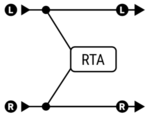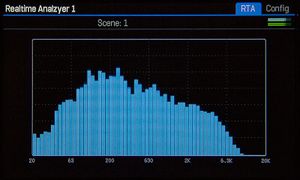This is the wiki for products made by Fractal Audio Systems, maintained by members of the community.
November 2025: the entire wiki has been updated with information about the new AM4 amp modeler.
Difference between revisions of "Realtime Analyzer block"
| Line 42: | Line 42: | ||
# The Input 1 yellow LED should be lit. Red should not be lit. Go to the RTA block Config tab. Set Bands to 128, Window to Blackman. Go to the RTA tab. There should be a narrow spike at 1 kHz (three bands). There should be no other bands showing power except maybe a little noise at the highest bands. The spike at 1 kHz should be about 2 1/4 divisions below full-scale | # The Input 1 yellow LED should be lit. Red should not be lit. Go to the RTA block Config tab. Set Bands to 128, Window to Blackman. Go to the RTA tab. There should be a narrow spike at 1 kHz (three bands). There should be no other bands showing power except maybe a little noise at the highest bands. The spike at 1 kHz should be about 2 1/4 divisions below full-scale | ||
| − | == | + | ==Measure devices== |
The RTA can be used to measure the output of other equipment, in conjunction with the [[Synth block]]. For example, to measure the frequency response of an external EQ or distortion pedal, set the Synth block to Pink Noise, send the Synth's signal through the pedal and back again, and use the RTA to measure and see the response. | The RTA can be used to measure the output of other equipment, in conjunction with the [[Synth block]]. For example, to measure the frequency response of an external EQ or distortion pedal, set the Synth block to Pink Noise, send the Synth's signal through the pedal and back again, and use the RTA to measure and see the response. | ||
Revision as of 13:09, 22 August 2019
Contents
Available on which products
- Axe-Fx III: 1 block
- FM3: yes
- Axe-Fx II: no
- AX8: no
- FX8: no
Channels or X/Y switching
- Axe-Fx III and FM3: no
Purposes
Watch audio spectrum
The RTA provides detailed visual feedback of the audio spectrum. To view the display, scroll to the RTA block and press Edit. It makes for a great dynamic display during performances.
Fight feedback
The RTA can point out frequencies where undesired feedback occurs. Turn the Value knob to select the desired band, and the frequency of the selected band will be displayed in the upper left corner. You can then use a PEQ to cut frequencies.
“Use it to identify problem frequencies or as a spiffy screen saver.” source
Test hardware I/O
The RTA can be used to test the hardware I/O. For example, to test the Instrument input: (source)
- Go to a blank preset
- Create a chain that connects Input 1 to the RTA block. On a separate row create a chain where the Synth block feeds Output 3
- Set the Synth Type = Sine, Tracking = Off, Frequency = 1000 Hz
- Connect an instrument cable from Output 3 (left or right) to the Instrument Input
- Set the Input 1 / Instrument A/D Input Level (Home->Setup->I/O) to 50%
- Turn the Out 3 Level knob all the way up
- The Input 1 yellow LED should be lit. Red should not be lit. Go to the RTA block Config tab. Set Bands to 128, Window to Blackman. Go to the RTA tab. There should be a narrow spike at 1 kHz (three bands). There should be no other bands showing power except maybe a little noise at the highest bands. The spike at 1 kHz should be about 2 1/4 divisions below full-scale
Measure devices
The RTA can be used to measure the output of other equipment, in conjunction with the Synth block. For example, to measure the frequency response of an external EQ or distortion pedal, set the Synth block to Pink Noise, send the Synth's signal through the pedal and back again, and use the RTA to measure and see the response.
Position of the RTA on the grid
The RTA block requires an input signal and doesn't send a signal out, so its output doesn't need to be connected.
Parameters
Parameters table
| Parameter | Axe-Fx III / FM3 |
|---|---|
| Decay Time | yes |
| Input Select | yes |
| Bands | yes |
| Window Type | yes |
Decay Time
To make the peaks remain longer visible, adjust Decay Time.

